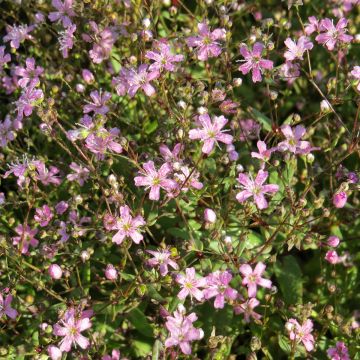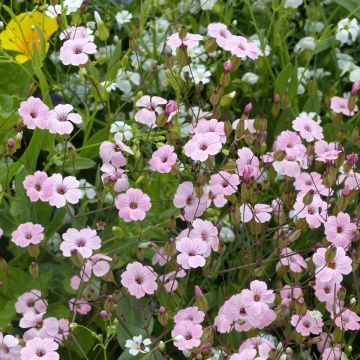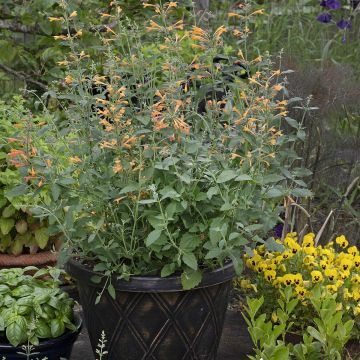

Echinacea purpurea 'Zonnehoed'
Echinacea purpurea 'Zonnehoed'
Echinacea purpurea Zonnehoed
Eastern purple coneflower, Purple coneflower
Special offer!
Receive a €20 voucher for any order over €90 (excluding delivery costs, credit notes, and plastic-free options)!
1- Add your favorite plants to your cart.
2- Once you have reached €90, confirm your order (you can even choose the delivery date!).
3- As soon as your order is shipped, you will receive an email containing your voucher code, valid for 3 months (90 days).
Your voucher is unique and can only be used once, for any order with a minimum value of €20, excluding delivery costs.
Can be combined with other current offers, non-divisible and non-refundable.
Why not try an alternative variety in stock?
View all →This plant carries a 6 months recovery warranty
More information
We guarantee the quality of our plants for a full growing cycle, and will replace at our expense any plant that fails to recover under normal climatic and planting conditions.
Would this plant suit my garden?
Set up your Plantfit profile →
Description
Echinacea purpurea, also known as Rudbeckia purpurea, is a flowering perennial, with an upright habit and vigorous growth. Its large flowers, with a deep pink colour and prominent orange-brown centre, bloom from June-July to August-September, attracting butterflies. It is ideal for flower beds, as well as for cutting or drying. It is also a very resilient and adaptable plant in relation to the soil. It is easy to sow and always successful in ordinary garden soil.
Native to the western United States, from Georgia to Michigan, passing through Oklahoma and Ohio, Echinacea purpurea is a resilient perennial that thrives in rocky meadows, savannas, open woodlands, and roadside edges. This intrepid pioneer has a dense and upright clump habit, reaching a height of 1m (3ft) and a width of about 40cm (16in). The leaves, opposite, lanceolate, and green, are covered in rough hairs. The fragrant flowering period lasts throughout the summer. The branched flower stems, reddish-green in colour, are topped by a solitary inflorescence with a prominent central disc, forming a cone of tiny florets in shades of copper-orange to brown. The outer collar is composed of ligules in a pink-red colour that fade slightly in the sun. The fruit is an achene that releases seeds that birds love. The deciduous foliage disappears in winter and regrows in spring. This plant firmly and deeply anchors itself in the soil with its well-developed root system.
The Purple Coneflower offers abundant and colourful flowering, pleasing to the eye when mixed with other pink flowers with contrasting forms (such as shrubby salvias, dwarf gladiolus, daylilies, carnations) or in the company of inulas, asters, yarrows, daisies, and globe thistles. Lighten up the scene by mixing in some ornamental grasses like Stipa tenuifolia or Muhlenbergia capillaris... Its flower is also beautiful in fresh or dried flower arrangements.
In homeopathy, the root of Echinacea is used to fight colds and strengthen the immune system. It was highly regarded by Native Americans. The name Echinacea comes from the Greek word echinos, meaning "hedgehog-like," and acea, meaning "having the shape of," alluding to the flower heads. Purpurea means "purple."
Flowering
Foliage
Plant habit
Botanical data
Echinacea
purpurea
Zonnehoed
Asteraceae
Eastern purple coneflower, Purple coneflower
North America
Other Flower seeds A to Z
View all →Planting and care
Sow the seeds of Purple Coneflower early in spring, from March to May, under cover, in trays filled with a special seed compost, maintained at 20-25°C (68-77°F). Cover the seeds with 1.5cm (1in) of compost. Germination takes 7 to 21 days. Take the seedlings out to harden them gradually, in a cooler area. Then transplant the plants that are large enough to handle, when all risk of frost has passed, with a spacing of 30cm (12in) between each plant. You can also sow outdoors from May to July, directly in place, in a well-cleaned and well-prepared soil. Thin out the sowing to leave only one plant every 30 or 40cm (12 or 16in), in full sun. Purple Coneflower takes its time to establish; indeed, its growth is rather slow. But in return, once in place, it requires no special care and is highly resistant to pests and diseases. It is best planted in spring, in a sunny location, in a mix of compost and garden soil. The soil should be deep and loose to accommodate its root system. Remove faded flowers as they appear. Divide the clump when flowering slows down. It is a rhizomatous plant that can become invasive if it likes its environment. As the plant ages, it becomes more susceptible to aphid attacks and powdery mildew. Mulch the base in May to retain moisture during summer, as it is sensitive to water shortage during flowering.
Sowing period
Intended location
Planting & care advice
This item has not been reviewed yet - be the first to leave a review about it.
Similar products
Haven't found what you were looking for?
Hardiness is the lowest winter temperature a plant can endure without suffering serious damage or even dying. However, hardiness is affected by location (a sheltered area, such as a patio), protection (winter cover) and soil type (hardiness is improved by well-drained soil).

Photo Sharing Terms & Conditions
In order to encourage gardeners to interact and share their experiences, Promesse de fleurs offers various media enabling content to be uploaded onto its Site - in particular via the ‘Photo sharing’ module.
The User agrees to refrain from:
- Posting any content that is illegal, prejudicial, insulting, racist, inciteful to hatred, revisionist, contrary to public decency, that infringes on privacy or on the privacy rights of third parties, in particular the publicity rights of persons and goods, intellectual property rights, or the right to privacy.
- Submitting content on behalf of a third party;
- Impersonate the identity of a third party and/or publish any personal information about a third party;
In general, the User undertakes to refrain from any unethical behaviour.
All Content (in particular text, comments, files, images, photos, videos, creative works, etc.), which may be subject to property or intellectual property rights, image or other private rights, shall remain the property of the User, subject to the limited rights granted by the terms of the licence granted by Promesse de fleurs as stated below. Users are at liberty to publish or not to publish such Content on the Site, notably via the ‘Photo Sharing’ facility, and accept that this Content shall be made public and freely accessible, notably on the Internet.
Users further acknowledge, undertake to have ,and guarantee that they hold all necessary rights and permissions to publish such material on the Site, in particular with regard to the legislation in force pertaining to any privacy, property, intellectual property, image, or contractual rights, or rights of any other nature. By publishing such Content on the Site, Users acknowledge accepting full liability as publishers of the Content within the meaning of the law, and grant Promesse de fleurs, free of charge, an inclusive, worldwide licence for the said Content for the entire duration of its publication, including all reproduction, representation, up/downloading, displaying, performing, transmission, and storage rights.
Users also grant permission for their name to be linked to the Content and accept that this link may not always be made available.
By engaging in posting material, Users consent to their Content becoming automatically accessible on the Internet, in particular on other sites and/or blogs and/or web pages of the Promesse de fleurs site, including in particular social pages and the Promesse de fleurs catalogue.
Users may secure the removal of entrusted content free of charge by issuing a simple request via our contact form.
The flowering period indicated on our website applies to countries and regions located in USDA zone 8 (France, the United Kingdom, Ireland, the Netherlands, etc.)
It will vary according to where you live:
- In zones 9 to 10 (Italy, Spain, Greece, etc.), flowering will occur about 2 to 4 weeks earlier.
- In zones 6 to 7 (Germany, Poland, Slovenia, and lower mountainous regions), flowering will be delayed by 2 to 3 weeks.
- In zone 5 (Central Europe, Scandinavia), blooming will be delayed by 3 to 5 weeks.
In temperate climates, pruning of spring-flowering shrubs (forsythia, spireas, etc.) should be done just after flowering.
Pruning of summer-flowering shrubs (Indian Lilac, Perovskia, etc.) can be done in winter or spring.
In cold regions as well as with frost-sensitive plants, avoid pruning too early when severe frosts may still occur.
The planting period indicated on our website applies to countries and regions located in USDA zone 8 (France, United Kingdom, Ireland, Netherlands).
It will vary according to where you live:
- In Mediterranean zones (Marseille, Madrid, Milan, etc.), autumn and winter are the best planting periods.
- In continental zones (Strasbourg, Munich, Vienna, etc.), delay planting by 2 to 3 weeks in spring and bring it forward by 2 to 4 weeks in autumn.
- In mountainous regions (the Alps, Pyrenees, Carpathians, etc.), it is best to plant in late spring (May-June) or late summer (August-September).
The harvesting period indicated on our website applies to countries and regions in USDA zone 8 (France, England, Ireland, the Netherlands).
In colder areas (Scandinavia, Poland, Austria...) fruit and vegetable harvests are likely to be delayed by 3-4 weeks.
In warmer areas (Italy, Spain, Greece, etc.), harvesting will probably take place earlier, depending on weather conditions.
The sowing periods indicated on our website apply to countries and regions within USDA Zone 8 (France, UK, Ireland, Netherlands).
In colder areas (Scandinavia, Poland, Austria...), delay any outdoor sowing by 3-4 weeks, or sow under glass.
In warmer climes (Italy, Spain, Greece, etc.), bring outdoor sowing forward by a few weeks.






































































